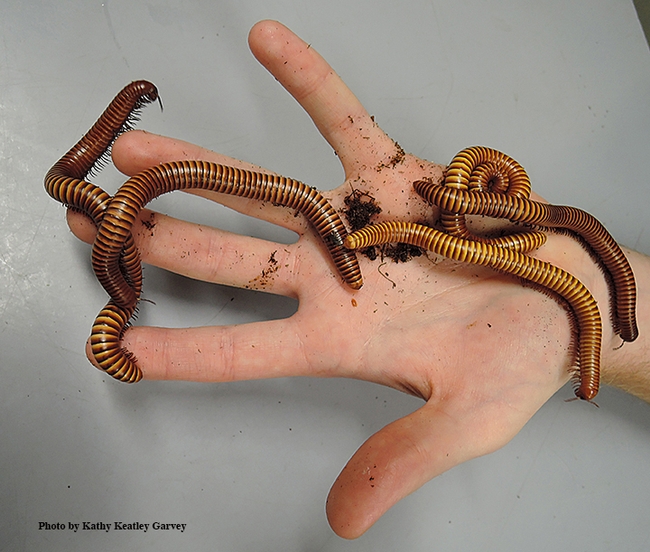
If you said "14," go to the head of the class.
Is it an insect? No, it's a crustacean.
When the Bohart Museum of Entomology hosts an open house on "Many-Legged Wonders" from 1 to 4 p.m., Saturday, March 18, among the critters showcased will be spiders, millipedes, centipedes, scorpions, tarantulas, and yes, isopods.
The event, free and family friendly, takes place in Room 1124 of the Academic Surge Building, 455 Crocker Lane, UC Davis campus.
Elijah Shih, a third-year UC Davis transfer student studying neurobiology, physiology and behavior, will show his isopods. “Isopods come in many morphs and sizes," he says. "There are many colorful and beautifully patterned isopods, some natural, some man made. Isopods are crustaceans and require moisture to breathe and molt properly. Some species have the ability to conglobate or roll up in to the ball where as others do not. They are great for helping create a bioactive system for reptiles, planted tanks, and a great feeder for young reptiles and amphibians.”
“There are many isopod species in the world," Shih related, “and at least five common isopod species that are found in California: Porcellio laevis, Porcellio scaber, Armadillidium vulgare, Porcellio dilatatus, and Cubaris marina. Their morphs are considered wild type.”
Shih, who hopes to pursue a career in veterinary medicine, said he houses “many reptiles, both aquatic and terrestrial, such as the box turtle and gargoyle gecko. I wanted to create bioactive environments for my reptiles—(mainly to not have to pick up the feces)-- so I looked for ways to make that possible. I need something that was small, agile, prolific, and safe to be eaten. Isopods, better known as Rollie pillows or pill bugs, are the best solution for me. I had my isopods, but to complete the cleanup crew, I added springtails to help clean up any leftover food, but more importantly, the mold.”
Tabatha Yang, education and outreach coordinator for the Bohart, announced that doctoral candidates Emma Jochim and Xavier Zahnle of the Jason Bond arachnology lab will dispel myths about spiders and millipedes at a question-and-answer session from 1 to 1:30. Doctoral student Iris Quayle will moderate.
From 1:30 to 4 p.m., will be the general open house with a showing of live animals and specimens. Bohart Museum research associate Brittany Kohler, the "zookeeper" of the Bohart petting zoo, says the current residents include:
- Princess Herbert, a Brazilian salmon-pink bird-eating tarantula (Lasiodora parahybana), age estimated to be around 20 (current oldest resident)
- Peaches, a Chilean rose hair tarantula (Grammostola rosea)
- Coco McFluffin, a Chaco golden knee tarantula (Grammostola pulchripes)
- Beatrice, a Vietnamese centipede (Scolopendra subspinipes), newest resident
- Two black widows (Latrodectus hesperus)
- One brown widow (Latrodectus geometricus)
Among the other residents are Madagascar hissing cockroaches, a giant cave cockroach, stick insects, a bark scorpion and ironclad beetles. A family arts-and-crafts activity is also planned.
The Bohart Museum, directed by UC Davis distinguished professor Lynn Kimsey, houses a global collection of eight million insect specimens, plus the petting zoo and a gift shop stocked with insect-themed books, posters, jewelry, t-shirts, hoodies and more. Dedicated to "understanding, documenting and communicating terrestrial arthropod diversity," the Bohart Museum was founded in 1946 and named for UC Davis professor and noted entomologist Richard Bohart. The insect museum is open to the public Mondays through Thursdays, from 8 a.m. to noon, and 1 to 5 p.m.
More information is available on the Bohart website at https://bohart.ucdavis.edu or by emailing bmuseum@ucdavis.edu.
Attached Images:

An isopod, a crustacean, has 14 legs. This is an Armadillidium gestroi, also known as high yellow spotted isopod, originating from the shores of France near limestone, sandstone, and granite. (Photo by Elijah Shih)

Tarantulas will be among the topics at the Bohart Museum of Entomology open house. (Photo by Kathy Keatley Garvey)

How many legs do millipedes have? Find out at the Bohart Museum of Entomology open house on March 18. (Photo by Kathy Keatley Garvey)